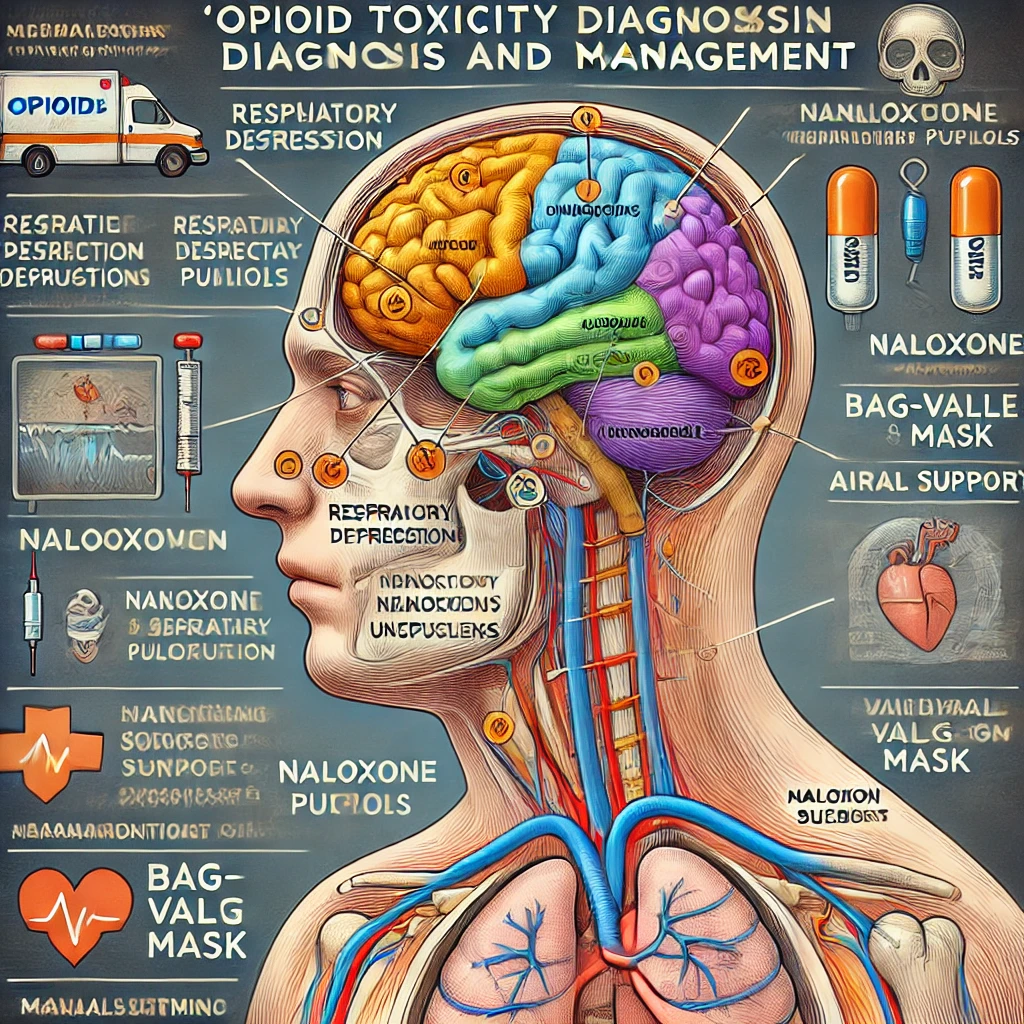Opioid Toxicity: Diagnosis and Management
Introduction
Opioid toxicity is a life-threatening condition resulting from excessive opioid exposure, leading to respiratory depression, altered mental status, and potential cardiovascular instability. Common opioids include morphine, heroin, oxycodone, fentanyl, codeine, tramadol, and methadone. This guide provides an in-depth look at diagnosis and management based on UK clinical guidelines.
Pathophysiology
Opioids act on mu (μ), kappa (κ), and delta (δ) receptors, primarily affecting the central nervous system (CNS) and respiratory centers in the brainstem. Toxicity results in:
- Respiratory depression (leading cause of mortality).
- Depressed consciousness (from mild drowsiness to coma).
- Miosis (pinpoint pupils) due to parasympathetic stimulation.
- Bradycardia and hypotension (vasodilation and decreased sympathetic tone).
For more details on opioid pharmacology, refer to the BNF opioid section.
Clinical Features
Classic Opioid Triad (Key diagnostic clue)
- Respiratory depression (slow, shallow breathing, or apnea).
- Altered mental status (drowsiness, confusion, coma).
- Miosis (pinpoint pupils) (may be absent in severe hypoxia or mixed overdose).
Other Symptoms
- Hypotension and bradycardia.
- Hypothermia (due to reduced metabolic rate).
- Decreased bowel sounds (opioid-induced ileus).
- Seizures (rare, but seen with tramadol and meperidine).
- Non-cardiogenic pulmonary edema (late stage).
More on symptoms and presentations can be found in NICE opioid poisoning guidelines.
Diagnosis
1. Clinical Assessment (ABCDE Approach)
- A – Airway: Assess for airway obstruction (snoring, gurgling).
- B – Breathing: Look for slow or irregular breathing, cyanosis, and low oxygen saturation.
- C – Circulation: Check for bradycardia, hypotension, and weak pulses.
- D – Disability: Assess GCS, pinpoint pupils, and opioid-associated encephalopathy.
- E – Exposure: Consider signs of IV drug use, needle marks, or transdermal opioid patches.
2. Investigations
- Arterial Blood Gas (ABG): Respiratory acidosis (↓ pH, ↑ PaCO₂) due to hypoventilation.
- Capnography: Reduced end-tidal CO₂ (ETCO₂) in respiratory depression.
- ECG: Prolonged QT (methadone), tachycardia (tramadol-induced serotonin syndrome).
- Serum toxicology: Opioid screening if unclear history.
- Blood glucose: Rule out hypoglycemia (common mimic of opioid toxicity).
Further investigation guidelines can be accessed via UKToxBase.
Management
1. Immediate Resuscitation (ABCDE Approach)
✅ Airway support – Ensure patency, use a jaw-thrust if necessary. ✅ Breathing support – Bag-mask ventilation (BMV) with 100% oxygen for hypoventilation. ✅ Circulation support – Monitor BP and heart rate, IV fluids if hypotensive.
2. Specific Treatment: Naloxone (Opioid Antagonist)
- Indication: Any opioid-induced respiratory depression.
- Dose:
- Initial IV bolus: 400 mcg (0.4 mg), repeated every 2-3 minutes until adequate respiration.
- If no response after 2 mg, reconsider diagnosis.
- Intramuscular (IM) or subcutaneous (SC) routes available in prehospital settings.
- Duration: Shorter than many opioids; monitor for re-sedation and repeat doses as necessary.
- Naloxone infusion: Used if long-acting opioids (e.g., methadone) involved – start at 60% of effective bolus dose per hour.
Read more about naloxone use in opioid toxicity via the BNF Naloxone Monograph.
3. Supportive Care
- Monitor for aspiration pneumonia (common in opioid overdoses).
- Prevent secondary hypoxia (high-flow oxygen therapy).
- Manage opioid withdrawal cautiously – sudden reversal can cause agitation, tachycardia, and hypertension.
4. Disposition
- Mild cases (responsive to naloxone): Observe for 4-6 hours in hospital.
- Severe cases (requiring ventilation or multiple naloxone doses): Admit to ICU.
- Consider psychiatric evaluation for intentional overdose cases.
Complications of Opioid Toxicity
- Respiratory failure and hypoxic brain injury.
- Aspiration pneumonia.
- Cardiac arrest (if severe hypoxia).
- Seizures (tramadol-related toxicity).
- Pulmonary edema (from opioid-induced capillary leak syndrome).
Prevention and Harm Reduction Strategies
- Prescribing safety: Use lowest effective opioid dose, consider non-opioid analgesia.
- Patient education: Warn about overdose risks, especially in opioid-naïve individuals.
- Opioid substitution therapy: Methadone or buprenorphine for opioid dependence.
- Naloxone distribution programs: Community-based naloxone kits for high-risk individuals.
More on harm reduction strategies can be found in the UK Government Opioid Strategy.
Conclusion
Opioid toxicity is a medical emergency requiring rapid identification and intervention. The mainstay of treatment is airway support, oxygenation, and naloxone administration. Preventative strategies, including patient education and opioid harm reduction programs, are essential in reducing opioid-related morbidity and mortality.
Further Reading and Resources:
- NICE Guidelines on Opioid Toxicity
- UK Resuscitation Council: Opioid Overdose Management
- British National Formulary (BNF): Naloxone Use

